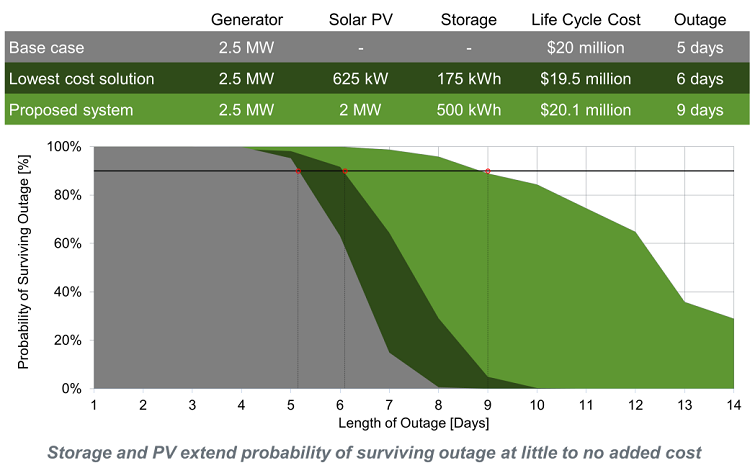REopt Evaluates Energy Security Measures for the Department of Defense

Results of an NLR REopt analysis conducted to evaluate opportunities for enhanced energy security at a military base. Illustration by Dylan Cutler and Emma Elgqvist
NLR used the REopt® model to help the Department of Defense evaluate opportunities for augmenting existing diesel generation with photovoltaic (PV) and battery systems to enhance energy security at a military base in the event of a power outage. The duration of outage sustained depends on the state of charge of the battery, critical load, and solar resource at the time of the outage. Through a REopt analysis, NLR evaluated thousands of random grid outages and durations throughout the year and compared the number of hours the site could survive with diesel generators and fixed fuel supply versus generators augmented with PV and battery systems.
NLR’s analysis revealed that the PV and battery system configuration with the lowest life cycle cost of energy results in $0.5 million of life cycle savings and extends the 90% probability of surviving an outage by one day. An alternate system configuration using the same methodology extends the 90% probability of surviving an outage by four days, at a life cycle cost of $0.1 million higher than the base case. The Department of Defense is using these results to quantify the three key values of solar plus storage: cost savings, energy savings, and resilience.
Related Stories
NLR presentation: Resilient Renewable Energy Microgrids
NLR poster: Optimizing Storage and Renewable Energy Systems with REopt
Journal of Energy Management article: Increasing Resiliency Through Renewable Energy Microgrids
NLR conference paper: Optimal Sizing of a Solar-Plus-Storage System For Utility Bill Savings and Resiliency Benefits
NLR poster: Optimizing Solar + Storage for Cost Savings and Resiliency
NLR technical report: New York Solar Smart DG Hub-Resilient Solar Project: Economic and Resiliency Impact of PV and Storage on New York Critical Infrastructure
Sponsors
Department of Defense
Contact
Share
Last Updated Dec. 7, 2025
